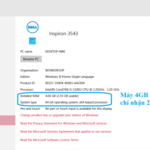Laptops going silent is not just frustrating for work, but can also hinder your leisure activities and online interaction. So, why does a laptop go silent? What are the causes and how can you fix it? Check out FPT Shop’s quick troubleshooting guide below.
Causes of a silent laptop
Laptops can go silent for a number of reasons, including:
- Playback Devices not enabled: If your laptop goes silent, it might be because your Playback Devices are not enabled. To check, right-click on the speaker icon in your Taskbar, then select Playback Devices. If your speakers are enabled, they will be highlighted in blue.
- Conflicting software: Software running on your computer may be conflicting with each other and causing your laptop to go silent.
- Hardware error: Over time, your computer’s hardware may develop errors. This can cause certain components to fail and lead to loss of audio. Check your computer for faulty hardware to troubleshoot accordingly.
- Human error (speakers not turned on, loose jack, low volume): Oversights like not turning on your speakers, having a loose jack, or having the speaker volume set too low, can also lead to your computer not producing sound.
/fptshop.com.vn/uploads/images/tin-tuc/178873/Originals/laptop-bi-mat-tieng-1.jpg)
Effective troubleshooting for silent laptops
Check the audio
Sometimes you may have inadvertently muted your computer’s audio with a keyboard shortcut without realizing it. So, be sure to check both the volume on your computer and external speakers to make sure they are turned on, and that the volume is set at an appropriate level to produce sound.
To check, simply click on the speaker icon in the Taskbar. If the sound is on, the speaker icon will turn pink. Also, double-check the speaker’s jack and power source. You need to make sure that the speakers are properly connected to your computer.
/fptshop.com.vn/uploads/images/tin-tuc/178873/Originals/laptop-bi-mat-tieng-2.jpg)
Check the volume in the application
Check if the audio is turned on in the program you’re using. Most applications have their own separate volume controls.
For example, DVD players usually come with their own volume controls, or you can turn up the volume directly on YouTube.
/fptshop.com.vn/uploads/images/tin-tuc/178873/Originals/laptop-bi-mat-tieng-3.jpg)
Restart your computer
If after checking both the speaker and application volume you’re still having issues with your laptop going silent, try shutting it down and restarting it. This will reset your computer’s system to its initial state. Doing so will fix issues like operating system bugs or software conflicts.
/fptshop.com.vn/uploads/images/tin-tuc/178873/Originals/laptop-bi-mat-tieng-4.jpg)
Check the drivers on your laptop
To check the audio drivers on your laptop, right-click on the speaker icon at the bottom right corner of your screen. Then follow these steps:
Step 1: The control panel interface will appear, select Playback Devices.
/fptshop.com.vn/uploads/images/tin-tuc/178873/Originals/laptop-bi-mat-tieng-5.jpg)
Step 2: Select the Speakers icon.
/fptshop.com.vn/uploads/images/tin-tuc/178873/Originals/laptop-bi-mat-tieng-6.jpg)
Step 3: Select Properties.
/fptshop.com.vn/uploads/images/tin-tuc/178873/Originals/laptop-bi-mat-tieng-7.jpg)
Step 4: Continue by selecting Use this Device (enable) at the bottom of the window, then click OK.
/fptshop.com.vn/uploads/images/tin-tuc/178873/Originals/laptop-bi-mat-tieng-8.jpg)
Recheck the connection port for headphones or speakers
If you can’t hear sound from your laptop’s built-in speakers, you may have plugged in a different device into the output port. This causes the sound to be automatically routed to it instead of the computer’s speakers. Double-check the ports and make sure everything is plugged in correctly.
Also, if you’re using an HDMI connection to a monitor that has built-in speakers, your audio may be lost because your HDMI video card is not set as your default audio device.
If your laptop has both a dedicated sound card and integrated audio on the motherboard, make sure that you have selected the correct output device in the Playback tab.
/fptshop.com.vn/uploads/images/tin-tuc/178873/Originals/laptop-bi-mat-tieng-9.jpg)
Use Microsoft FixIt Troubleshooters
Microsoft has now released a solution for users to fix audio issues in Windows. This solution is called Microsoft FixIt Troubleshooters. To use it, follow these steps:
Step 1: Go to Start and select Control Panel.
/fptshop.com.vn/uploads/images/tin-tuc/178873/Originals/laptop-bi-mat-tieng-10.jpg)
Step 2: Find and click on Troubleshooting.
/fptshop.com.vn/uploads/images/tin-tuc/178873/Originals/laptop-bi-mat-tieng-11.jpg)
Step 3: Under Hardware and Sound, click on Troubleshoot audio playback.
/fptshop.com.vn/uploads/images/tin-tuc/178873/Originals/laptop-bi-mat-tieng-12.jpg)
Step 4: In the new window that appears, click on Next to start the audio troubleshooting program.
/fptshop.com.vn/uploads/images/tin-tuc/178873/Originals/laptop-bi-mat-tieng-13.jpg)
Update your BIOS
Some Sony and Toshiba laptops require a BIOS update to fix sound issues. Sometimes, the audio will stop working after you’ve upgraded your system or downloaded updates. To fix this issue, you’ll need to go to your computer manufacturer’s official website and download the latest BIOS version.
Another method is to check inside the BIOS to make sure that the audio card is enabled. Sometimes the audio device can get disabled in BIOS. This way, no matter what changes you make in Windows, they won’t fix your laptop’s loss of audio.






































